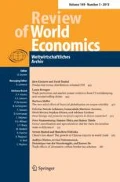Abstract
Exploring the Limits of Comparative Advantage. - The paper examines extensions of the Law of Comparative Advantage to several situations that have not been adequately covered before. The basic result is the positive one that a country’s pattern of trade will be negatively correlated with its relative autarky prices. The first extension is to situations of unbalanced trade. The second extension is to an economy with domestic distortions. Finally, the third extension is to a lumpy country model, in which regions of a country may differ in various ways, including differences in factor prices.
Zusammenfassung
Erforschung der Grenzen des Gesetzes der komparativen Vorteile. — Auf dem Prüfstand steht in diesem Artikel das Gesetz der komparativen Vorteile, das auf verschiedene Situationen, die bis jetzt nicht ausreichend behandelt worden sind, ausgedehnt wird. Das Hauptergebnis ist ein positives, nämlich daß die Struktur des Außenhandels eines Landes mit seinen relativen Autarkiepreisen negativ korrelieren wird. Die erste Ausdehnung des Gesetzes erfolgt auf Situationen mit ungleichgewichtigem Handel, die zweite auf eine Volkswirtschaft mit Verzerrungen auf den heimischen Märkten. Schließlich erfolgt die dritte Ausdehnung auf das Modell eines inhomogenen Landes, in dem die Regionen auf verschiedene Weise differieren können, auch in bezug auf Unterschiede in den Faktorpreisen.
Similar content being viewed by others
References
Bhagwati, Jagdish, V.K. Ramaswami, “Domestic Distortions, Tariffs and the Theory of Optimum Subsidy.”Journal of Political Economy, Vol. 71, 1963, pp. 44–50.
Courant, Paul N., Alan V. Deardorff [1992a], “International Trade with Lumpy Countries.”Journal of Political Economy, Vol. 100, 1992, p. 198–210.
— [1992b],Migrant Landlords and Trade in a Lumpy Country. Research Forum on International Economics Discussion Papers, 305, University of Michigan. Ann Arbor 1992.
— “Amenities, Nontraded Goods, and the Trade of Lumpy Countries.”Journal of Urban Economics, Vol. 34, 1993, pp. 299–317.
Deardorff, Alan V., “The General Validity of the Law of Comparative Advantage.”Journal of Political Economy, Vol. 88, 1980, pp. 941–957.
-, “Testing Trade Theories and Predicting Trade Flows.” In: Ronald W. Jones, Peter B. Kenen (Eds.),Handbook of International Economics, Vol. I. New York 1984, Chapter 10, pp. 467–517.
—, “Comparative Advantage and International Trade and Investment in Services.” In: Robert M. Stern (Ed.),Trade and Investment in Services: Canada/U.S. Perspectives. Ontario Economic Council, Toronto 1985, pp. 39–71.
-, “Directions of Lumpy Country Trade.” In: Wilfried Ethier, Elhanan Helpman, J. Peter Neary (Eds.),Theory, Policy and Dynamics in International Trade: Essay in Honor of Ronald W. Jones. Cambridge 1993, pp. 55–72.
Dixit, Avinash K., Victor Norman,Theory of International Trade. Cambridge 1980.
Ethier, Wilfred J., Lars E.O. Svensson, “The Theorems of International Trade with Factor Mobility.”Journal of International Economics, Vol. 20, 1986, pp. 21–42.
Haberler, Gottfried, “Some Problems in the Pure Theory of International Trade.”The Economic Journal, Vol. 61, 1950, pp. 777–784.
Helpman, Elhanan, “Increasing Returns, Imperfect Markets, and Trade Theory.” In: Ronald W. Jones and Peter B. Kenen (Eds.),Handbook of International Economics, Vol. 1. New York, 1984, Chapter 7.
-, “Comparative Advantage under Uncertainty.” In: Helmut Hesse, Erich Streissler, Gunter Tichy (Eds.),Auβenwirtschaft bei Ungewiβheit. Tübingen 1985, pp. 72–88.
Johnson, Harry G., “Optimal Trade Intervention in the Presence of Domestic Distortions.” In: Richard E. Caves, Harry G. Johnson, Peter B. Kenen (Eds.),Trade, Growth and the Balance of Payments. Chicago 1965, pp. 142–170.
Krugman, Paul R., “Is Free Trade Passé?“Journal of Economic Perspectives, Vol. 1, 1987, pp. 131–144.
—, “What Do Undergrads Need to Know About Trade?“The American Economic Review, Vol. 83, 1993, pp. 23–26.
Svensson, Lars E.O., “Trade in Risky Assets.”The American Economic Review, Vol. 78, 1988, pp. 375–394.



